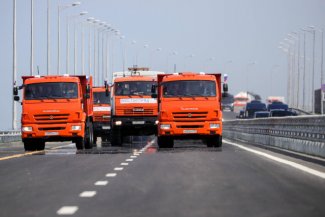The opening of the bridge from Russia to Crimea

On 15 May, Vladimir Putin officially opened the bridge connecting Russia with the Crimean Peninsula via the Kerch Strait. Putin, sitting behind the wheel of a Kamaz truck, drove to Crimea in a column of trucks. The commemorative journey was broadcast live by the Russian media. As of 16 May, more than six months before the scheduled date (December 2018), cars and public transport will be able to use the bridge. The crossing for heavy goods vehicles will be opened in October this year, while the construction of the railway bridge should be completed behind schedule, in December 2019. The bridge is designed for a daily capacity of 40,000 cars and 47 trains in both directions. The decision to build the bridge was taken by the Russian President in April 2014, just after the annexation of Crimea. Construction work on the 19 km-long road-rail crossing (the longest in Europe) started at the beginning of 2016 and has cost 228 billion rubles (nearly US$3.8 billion) of public funds. The construction of the bridge has been consistently opposed by Ukraine, recognising this as a violation of its territorial integrity. Ukraine has also stressed the negative effects of the investment on the environment, fishing and shipping. Kiev has brought a case to the Court of Arbitration in the Hague for a violation by Russia of the United Nations Convention on the Law of the Sea.
Commentary
- The opening of the bridge to Crimea, especially half a year before the official deadline, is a success for the Russian authorities. The project was a priority for the Kremlin. It was aimed at demonstrating the capability of the Russian state to both Russian society and the West, particularly as the construction of the crossing was subject to Western sanctions, in connection with Russia’s illegal annexation of the peninsula, which hindered the contractor’s access to foreign technology and capital, including problems with insuring the investment. As it turned out, the restrictions were not fully respected, as evidenced by the proceedings initiated this year by the Dutch public prosecutor into seven companies from that country which in 2015-17 allegedly delivered some of the heavy equipment used for this investment.
- The financial beneficiary of the bridge’s construction is Arkady Rotenberg, a close friend of President Putin (and his sparring partner in martial arts). Rotenberg’s company Stroygazmontazh became the main contractor without any tenders being held. During Putin’s presidency, Rotenberg and his brother Boris made money from property (currently estimated at around US$5.5 billion) in public procurement. Their companies have received the most lucrative contracts from state-owned companies, notably Gazprom.
- Since the annexation of Crimea, the Kremlin has been trying to integrate the infrastructure of the peninsula with Russia, especially as since 2015 the peninsula has been covered by a Ukrainian economic blockade. The Crimean bridge is an important part of the Russian project. Its launch significantly improves the situation of the peninsula, to which goods have hitherto been delivered mainly by sea. Part of the so-called energy bridge, supplying Crimea with electricity, had already been given over for use; work on expanding this network is ongoing. In addition, in 2017 the undersea gas pipeline linking the Russian Kuban with Crimea (also built by Stroygazmontazh) was activated. However, access to fresh water remains one of the peninsula’s problems.






